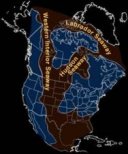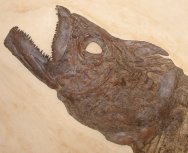Ichthyodectes ctenodon
Phylum Chordata, Class Actinopterygii; Infraclass (or subdivisions) Teleostei, Subclass Chondrostei, Order Polypteriformes, Family Ichthyodectidae, Subfamily Ichthyodectinae
Geological Time: Cretaceous (~83 m.y.a.)
Size: 72 inches (~ six feet)
Fossil Site: Niobrara Formation, Smoky Hill Chalk, Gove County, Kansas,
|
Ichthyodectes is a member of Infraclass Teleostei, one of three infraclasses in class Actinopterygii, the ray-finned fishes. The Teleostei comprise a diverse group that arose in the Triassic period descending to some 20,000 extant species across some 40 orders. Found at all depths, Teleostei contain many well known fishes, including eels, salmon, trou, catfish, tarpon, tuna, halibut, flounder and cod. By the end of the Cretaceous Period, the teleosts had become the dominant fishes in both the marine and freshwater environments. Teleosts are primarily differentiated by a fully movable maxilla and premaxilla that form the biting surface of the upper jaw. The upper jaw is movable, enabling them to protrude their jaws when feeding. |


